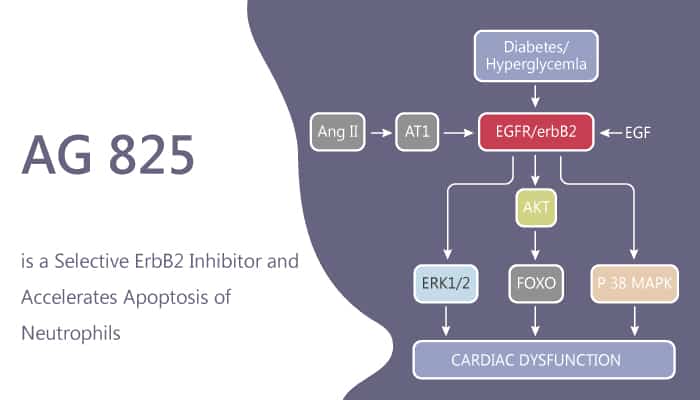The ErbB tyrosine kinase receptor (RTK) family has 4 members: ErbB1 (EGFR/HER1), ErbB2 (HER2/neu), ErbB3 (HER3), and ErbB4 (HER4). These receptors are cell surface receptors and play important roles in cell proliferation, survival, and growth signaling.
ErbB2 is an orphan receptor; it can associate with other ErbBs to enhances signaling intensity and dimer stability.
ErbB2 overpresses and amplifies in various malignancies. Noticeably, ErbB2 overexpression especially presents in breast cancer. As a result, targeting ErbB2 for breast cancer therapy is very necessary and indispensable.
Today, we will introduce a selective ErbB2 inhibitor, AG-825.
AG-825 leads to a decrease in ErbB2–nucleolin interaction, which suppresses tyrosine phosphorylation. It has anti-cancer activities.

Firstly, in vitro, AG-825 (40μM) has a negative impact on ErbB2–nucleoin complex formation in SKBR3 and MDCK cells. GroA (AS1411) is a G-rich oligonucleotide, reduces ErbB2 phosphorylation. Since GroA is beneficial in terms of cancer treatment, AG-825 combinates with it for treatment is researched for targeting breast cancer.
In SKBR3 and MDCK cells, AG-825 and GroA combination significantly decreases viable cells number. However, treatment alone is less effective. Furthermore, this combination erects a long-term effect on cell colony formation. They obviously decrease the total area of colonies in two cell lines.
Secondly, in MCF7 ErbB2-overexpressing clone cells, AG-825 (40μM) down-regulates ErbB2 phosphorylation expression. Moreover, AG-825 combines with GroA has a more prominent effect on the activation of ErbB2 than a single dose.
Thirdly, in the BrdU incorporation assay, co-treatment with GroA and AG-825 obviously enhances cell death when compares to the single-drug treatments.
Lastly, as we all know, Using a three-dimensional cell culture can allow the investigation of the anchorage-independent growth ability of the cells and the level of culture organization. In three-dimensional SKBR3 cell culture, GroA and AG-825 interfere with the ability of SKBR3 cells to grow in an anchorage-independent manner. However, combination treatment has no effect on growth morphology. AG-825 and GroA significantly decrease the number of cells which can invade through the Cultrex basement membrane.
In conclusion, AG-825, as a selective ErbB2 inhibitor, although it is not applicable in vivo at present, it has the potential for breast treatment when combines with GroA.
Reference:
Wolfson E, et al. Cell Death Dis. 2018 Jan 19;9(2):47.